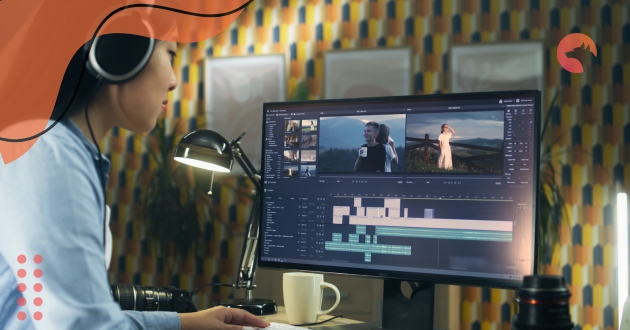How to choose video editing software can feel overwhelming, especially if you are just starting out in the world of video creation. With numerous options available, each with its own strengths and weaknesses, it is easy to feel lost.
When thinking about how to choose video editing software, it’s important to consider your specific needs and skill level. There are tools designed for beginners that offer simplicity, and others created for professionals that come packed with features and customization options.
Moreover, learning how to choose video editing software involves understanding the types of projects you will work on. Whether you are creating short clips for social media or producing long documentaries, different software packages cater to different needs.
Key Features to Consider

1. Ease of Use
First and foremost, ease of use is a major factor when choosing video editing software. If you’re a beginner, it’s best to opt for software with an intuitive interface, built-in tutorials, and drag-and-drop features.
Popular beginner-friendly tools like iMovie or Filmora can help you get started without overwhelming you with advanced options. On the other hand, professionals may prefer something more robust like Adobe Premiere Pro or DaVinci Resolve, which have steeper learning curves but offer more control and functionality.
2. Compatibility
Another critical aspect is compatibility. Ensure the software you choose works well with your computer system, including its operating system and hardware capabilities.
Video editing can be demanding, and certain software might require more processing power, RAM, or specific graphics cards. Double-check that the software you plan to use is fully compatible with your device to avoid issues down the line.
Software Features and Flexibility
1. Editing Tools
The range of editing tools is another essential aspect to evaluate. Basic video editing software should include features like trimming, splitting, and merging clips. More advanced tools offer enhanced features such as multi-cam editing, green screen effects, and advanced audio editing.
Understanding what you need from these tools can help ensure that the software will meet both your current and future needs.
2. Export and Sharing Options
Consider the export options that the software provides. If you frequently share videos on platforms like YouTube, Instagram, or TikTok, you’ll want software that offers direct export to these platforms or presets that make it easy to create platform-specific content.
File format compatibility is also important, as you may need to export your project in various formats depending on its intended use.
3. Price and Subscription Models (How to choose video editing software)
When deciding how to choose video editing software, budget plays a crucial role. Some software is available for free but may have limited features or include watermarks on your videos. Paid software often comes in the form of one-time purchases or subscription models.
It’s important to consider how often you’ll be using the software and whether the recurring cost fits into your budget. Tools like Final Cut Pro require a one-time payment, while others like Adobe Premiere Pro use a subscription model.
Popular Video Editing Software
1. Adobe Premiere Pro
Adobe Premiere Pro is a leading choice for professional video editors, offering a comprehensive suite of tools and advanced features. It is widely used in the film and television industry and provides integration with other Adobe products for a seamless editing experience.
2. DaVinci Resolve (How to choose video editing software)
DaVinci Resolve is known for its powerful color correction capabilities and is also widely used by professionals. It combines editing, color correction, visual effects, and audio post-production into one software, making it a versatile option for those who need a complete editing solution.
3. CyberLink PowerDirector 365
CyberLink PowerDirector 365 is a feature-rich video editing software that balances ease of use with powerful tools. It is suitable for both beginners and more advanced users and offers a subscription model with access to regular updates and new features.
4. Wondershare Filmora
Wondershare Filmora is an excellent choice for beginners and casual editors. It offers a user-friendly interface and a variety of pre-made effects, making it easy to create polished videos quickly. It’s ideal for content creators who need a straightforward and affordable solution.
5. Final Cut Pro (How to choose video editing software)
Final Cut Pro is a favorite among Mac users, offering powerful editing capabilities with a one-time purchase cost. It is particularly known for its magnetic timeline and advanced organization tools, making it a popular choice for both amateurs and professionals working within the Apple ecosystem.
Related Tips for Improving Your Editing Skills
For those looking to improve their overall video production quality, it’s important to also consider your skills in capturing high-quality footage. Check out these tips for digital photography for beginners, which can help you take better videos and photos, leading to more professional-looking edits. Combining strong footage with the right video editing software is key to achieving exceptional results.
FAQ: How to Choose Video Editing Software
1. What is the best video editing software for beginners?
For beginners, software like Wondershare Filmora or iMovie is often recommended due to their intuitive interfaces and easy-to-use features. These tools are designed to help beginners create quality videos without the complexity of professional-grade options.
2. What features should I look for in video editing software?
You should look for features that match your needs, such as ease of use, compatibility with your system, essential editing tools, and export options. For advanced users, features like multi-cam editing, color correction, and audio enhancements are important.
3. Is free video editing software good enough?
Free video editing software can be sufficient for simple projects. Tools like DaVinci Resolve offer robust free versions, but they may include limited features compared to paid versions. Consider your project requirements to determine if a free tool meets your needs.
4. How much should I spend on video editing software?
The amount you spend depends on how frequently you edit videos and your requirements. Subscription models like Adobe Premiere Pro are ideal for professionals needing regular updates, while one-time payment options like Final Cut Pro can be more budget-friendly in the long term.
Conclusion (How to choose video editing software)
Selecting the right video editing software can make all the difference in your creative journey. With the vast number of available options, the key is to identify software that aligns with your skill level, budget, and project requirements.
It’s also important to consider compatibility, as using software that runs smoothly on your existing hardware can save you from unnecessary frustration. The editing tools, export options, and the pricing model should also be weighed according to how you plan to use the software and your future growth as a content creator.
Ultimately, the process of how to choose video editing software is about finding a solution that feels comfortable for you and enhances your creativity. Take the time to explore, experiment, and learn, and you’ll find the software that will help you bring your creative vision to life.



